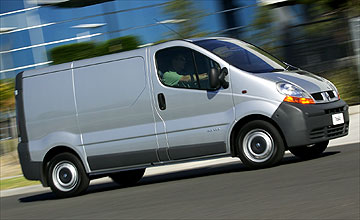BY MARTON PETTENDY | 2nd Apr 2004

And Renault hopes Trafic – which competes in the volume-selling medium van segment - will be good for it, too, hitting the market at the beginning of the traditional LCV-buying months prior to the end of the financial year.
The first example, the mid-sized Trafic, goes on sale here in the same month as Volkswagen’s all-new T5 Transporter range – pricing for which has not been announced, but is expected to rise to the Trafic’s low-$30,000s entry point.
Trafic is also priced almost lineball with its direct competitor, the Mercedes-Benz Vito, which opens at $32,720 and with which Trafic also rivals in terms of size, payload, performance and features.
As such, Renault says styling and safety will be key Trafic selling points, claiming the French van is the most stylish in class and offers more "status and image to its owner and their business".
Trafic’s rising roof section over the cockpit area is certainly unique, and the oh-so-French headlights and tail-lights - which are concealed behind edgy, transparent lenses – also set the big Renault apart from its rivals.
The safety message isn’t quite as convincing. Yes, Trafic comes standard with a driver’s airbag, load-limiting seatbelts, height-adjustable seatbelt anchors and four-wheel disc brakes (which are claimed to provide class-leading 100-0km/h braking capabilities), but important safety features like ABS and a passenger airbag are only available as a $2300 option.
Granted, the advanced electronic brake-force distribution technology is also part of this package, and Trafic’s – which is pressed into service by the French police force - galvanized high strength steel body has programmed deformation zones like a passenger car.
Trafic meets all the usual LCV requirements, including low running costs from a clean and frugal but extremely tractable, high-tech turbo-diesel, low maintenance costs via reasonably spaced service intervals, and a square triple-illuminated cargo space with adjustable anchor points and practical loading access both rear and kerb-side.
Renault even claims Trafic respects the environment more than most, with 90 per cent of its components being recyclable and its brake pads and clutch facings being lead-free.
Trafic’s interior is highly user-friendly, with a deep, expansive dashboard featuring plenty of tray space to store documents and other oddments, including twin lower shelving, plus two industrial-sized cup-holders, massive door pockets and a big (but unlockable) glovebox.
There is even a central LCD information display, revealing a clock, audio details and outside temperature, plus a handy internal locking button and LCD trip meter.
Reasonably flat but comfortable, durably trimmed seats offer just enough lateral support for a commercial vehicle, a conveniently-placed, dash-mounted gearshifter afford the cabin walk-through ability (a load space partition will be an accessory), and steering wheel-mounted audio controls further enhance Trafic’s ergonomics.
Other options like all-important air-conditioning ($2800) and convenient power windows/mirrors plus keyless entry ($1100) aren’t cheap, but at least the power window option includes an auto up and down function and the $500 introductory air-con offer should lighten the wallets of Trafic buyers a little less. And, besides effective venting, it adds the practicality of a chilled glovebox.
Best thing about Trafic, however, is its highly civilised performance, handling, refinement and seating position.
Sitting behind – rather than on top of – the steering wheel and instruments, Trafic offers a car-like driving position compared to most of its van rivals, which often also place their drivers dangerously close to the windscreen and steering wheel – which, surprisingly, in this case is adjustable for reach but not height.
Trafic offers no such psychological concerns and comes complete with stylish instruments, well placed pedals, good vision in all directions and – despite an industrial-look load area that lacks any internal cladding – a cabin quiet enough to make bargain-basement entry-level vans like Kia’s Preggio seem positively agricultural in comparison.
Performance from the 1.9-litre turbo-diesel is gutsy but civilised, but the short-wheelbase version we drove (with a 440kg load on board) exhibited a degree of turbo lag during sudden throttle openings, especially off-idle.
However, a considerable turbo rush is delivered anywhere within Trafic’s meaty midrange, topping out around 3800rpm (there is no redline), and bottom-end torque is impressive enough to make stalling Trafic virtually unheard of.
Driveability is the key here and Trafic offers it in spades, thanks to a willing engine and responsive clutch and short-throw gearshift controls making light work of the sensibly geared six-speed manual gearbox.
Renault claims Trafic’s MacPherson strut front (anti-roll bar) and torsion beam rear suspension offers passenger car-like handling, so much so that a number of camper-conversion houses are expected to take up the challenge of fitting rear seats and the like.
Though our time in it was limited to semi-rural roads, it’s clear Trafic is civilised enough for such work, with nicely weighted steering largely unaffected by engine torque, an excellent turning circle, reasonably good vision in all directions, acceptable ride quaility and a well-isolated, relatively comfortable cabin.
There are plenty worse places in which to spend a day on the road than in Trafic.